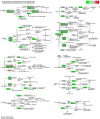Tumoral expression of drug and xenobiotic metabolizing enzymes in breast cancer patients of different ethnicities with implications to personalized medicine
- PMID: 28684774
- PMCID: PMC5500564
- DOI: 10.1038/s41598-017-04250-2
Tumoral expression of drug and xenobiotic metabolizing enzymes in breast cancer patients of different ethnicities with implications to personalized medicine
Abstract
Drug and xenobiotic metabolizing enzymes (DXME) play important roles in drug responses and carcinogenesis. Recent studies have found that expression of DXME in cancer cells significantly affects drug clearance and the onset of drug resistance. In this study we compared the expression of DXME in breast tumor tissue samples from patients representing three ethnic groups: Caucasian Americans (CA), African Americans (AA), and Asian Americans (AS). We further combined DXME gene expression data with eQTL data from the GTEx project and with allele frequency data from the 1000 Genomes project to identify SNPs that may be associated with differential expression of DXME genes. We identified substantial differences among CA, AA, and AS populations in the expression of DXME genes and in activation of pathways involved in drug metabolism, including those involved in metabolizing chemotherapy drugs that are commonly used in the treatment of breast cancer. These data suggest that differential expression of DXME may associate with health disparities in breast cancer outcomes observed among these three ethnic groups. Our study suggests that development of personalized treatment strategies for breast cancer patients could be improved by considering both germline genotypes and tumor specific mutations and expression profiles related to DXME genes.
Conflict of interest statement
Jinfeng Zhang is the founder of Insilicom LLC.
Figures




References
-
- American Cancer Society Cancer Facts & Figures 2016 (American Cancer Society, Atlanta, 2016).
-
- Harper S, et al. Trends in area-socioeconomic and race-ethnic disparities in breast cancer incidence, stage at diagnosis, screening, mortality, and survival among women ages 50 years and over (1987–2005) Cancer Epidemiol Biomarkers Prev. 2009;18:121–131. doi: 10.1158/1055-9965.EPI-08-0679. - DOI - PubMed
MeSH terms
Substances
LinkOut - more resources
Full Text Sources
Other Literature Sources
Medical
Research Materials

